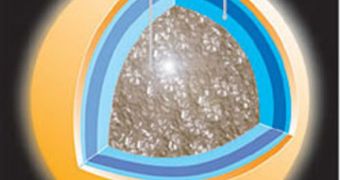A paper published in the January 29th issue of the journal Geophysical Research Letters confirms what astronomers have been suspecting for the past couple of years, and namely that the atmosphere around Saturn's moon, Titan, which is approximately 10 times denser than that of the Earth, is capable of producing clouds of methane that consequentially form rain. These precipitations can fill larger craters on the moon's surface, and thus give birth to new lakes, filled with hydrocarbons.
The natural satellite has a diameter of about 3,200 miles (5,150 kilometers), and is larger in size than Mercury. It's also about 40 percent the size of the Earth, and harbors a large variety of lakes on its surface, as evidenced by the latest findings sent back by the Cassini space probe.
By comparing data on the same region of Titan from two separate flights, one in 2004 and another in 2005, researchers at the Johns Hopkins University Applied Physics Laboratory, in Laurel, Maryland, led by Cassini imaging team associate Elizabeth Turtle, have managed to determine that in less than a year a lake was formed in a place where nothing was visible a twelvemonth before. The same instrument aboard Cassini, the Imaging Science Subsystem (ISS), was used for both sets of pictures.
This find only comes to strengthen the belief that a system of volcanoes on the moon's surface fuels the atmosphere with methane, allowing it to condense in the air, and then fall back down as rain. Liquid hydrocarbons thus fill crater holes and create lakes on the surface of the satellite, a fact that is most obvious in its northern regions, which seem to be more rich in the stuff than the southern ones.
"The clouds, when we look at them over a period of a few hours, behave like convective clouds, the same way you have thunderstorms on Earth. If you watch them over a few hours, they kind of billow upwards the same way thunderheads do on Earth," Turtle told Space. "Our new map provides more coverage of Titan's poles, but even if all of the features we see there were filled with liquid methane, there's still not enough to sustain the atmosphere for more than 10 million years."
Although Cassini has supplied NASA with valuable information of Saturn and its moons over the years, the funding for the program is set to come to an end on September 30th, 2010. Project managers are currently putting a file together, which they will soon present at the agency's headquarters, in hopes of getting a seven year-extension on the program, along with the much-needed funds.

 14 DAY TRIAL //
14 DAY TRIAL //